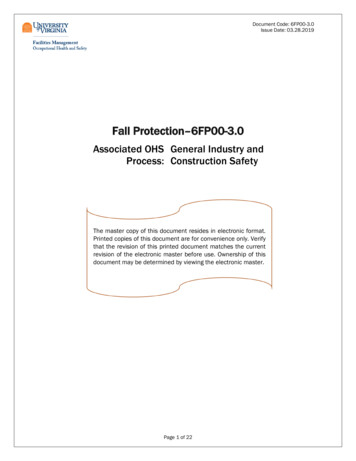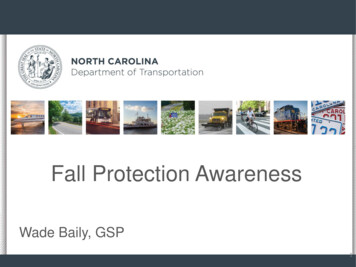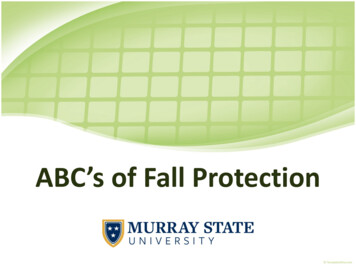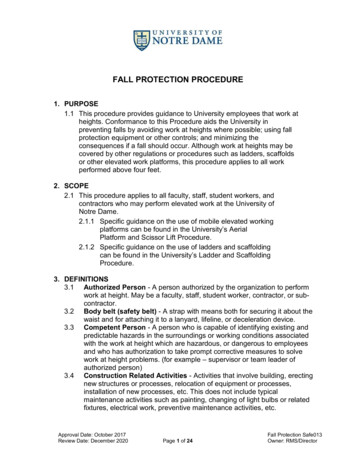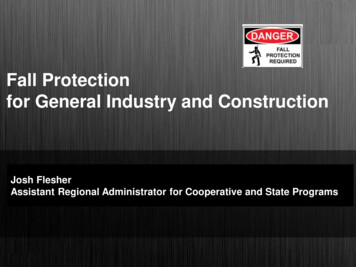
Transcription
Fall Protectionfor General Industry and ConstructionJosh FlesherAssistant Regional Administrator for Cooperative and State Programs
Workplace Injuries, Illnesses andFatalities4,585 workers were killed on the job in 2013(3.3 per 100,000 full-time equivalent workers) –on average, 88 a week or more than 12 deathsevery day. (This is the second lowest total sincethe fatal injury census was first conducted in1992.)BLS 2013 workplace fatality data
Falls in ConstructionFALLS ARE THE LEADING CAUSE OFDEATH IN CONSTRUCTION. In 2013, therewere 291 fatal falls to a lower level out of828 total fatalities in construction. Thesedeaths are preventable.
Construction Fatal FourFalls 302 36.5%Electrocution 71 8.6%Struck-by 84 10.1%Caught By 21 2.5%
Subpart M – Fall ProtectionRequirement and criteria for fall protection inconstruction.Examples:oooooHeights of 6 feet or more above lower levelsFall objectsFalls from trippingFalling through holesProtection walking and working around equipmentThe provisions of Subpart M can be found in Title 29 Code of FederalRegulations (CFR) Subpart M - Fall Protection, 29 CFR 1926.500, 29 CFR1926.501, 29 CFR 1926.502, and 29 CFR 1926.503.
Employers’ Responsibilities Assess the workplace to determine ifwalking or working surfaces have necessarystrength and structural integrity to safelysupport workers. Determine the work surfaces will safelysupport work activity. Employer must determine whether fallprotection is required.29 CFR 1926.501 and 1926.502
FallsThe following hazards cause the most fallrelated injuries: Unprotected Sides, Wall Openings, andFloor Holes Improper Scaffold Construction Unguarded Protruding Steel Rebars Misuse of Portable Ladders
Am I in Danger?How do I avoid Hazards? Use at least one of the following wheneveremployees are exposed to a fall of 6 feet or moreabove a lower level:– Guardrail Systems, Safety Net Systems.Personal Fall Arrest SystemsCover or guard floor holes as soon as they arecreated during new construction.Existing structures, survey the site before workingand continually audit as work continues. Guard orcover any openings or holes immediately.Construct all floor hole covers so they willeffectively support two times the weight ofemployees, equipment, and materials that may beimposed on the cover at any one falls/mainpage.html
Am I in Danger?How Do I Avoid Hazards? Construct all scaffolds according to themanufacturer's instructions.Install guardrail systems along all open sidesand ends of platforms.Use at least one of the following for scaffoldsmore than 10 feet above a lower level:– Guardrail Systems– Personal Fall Arrest SystemsProvide safe access to scaffold platforms.[Scaffold Access]Do not climb cross-bracing as a means ofaccess.
Am I in Danger?How Do I Avoid Hazards? Guard all protruding ends ofsteel rebar with rebar caps orwooden troughs, orBend rebar so exposed ends areno longer upright.When employees are working atany height above exposed rebar,fall protection/prevention is thefirst line of defense againstimpalement.
Am I in Danger?How Do I Avoid Hazards? Position portable ladders so the side rails extendat least 3 feet above the landing.Secure side rails at the top to a rigid support anduse a grab device when 3 foot extension is notpossible.Make sure that the weight on the ladder will notcause it to slip off its support.Before each use inspect ladders for cracked orbroken parts such as rungs, steps, side rails, feetand locking components.Do not apply more weight on the ladder than it isdesigned to support. [Ladder Safety]Use only ladders that comply with OSHA designstandards. [29 CFR 1926.1053(a)(1)]
Fall Protection in General IndustryFalls are among the most commoncauses of serious work-relatedinjuries and deaths. Employersmust take measures in theirworkplaces to prevent employeesfrom falling off overhead platforms,elevated work stations or intoholes in the floor and walls.
Prevent Employees From BeingInjured from Falls Guard every floor hole into which a workercan accidentally walk by use of a railing andtoeboard or a floor hole cover. Provide a guardrail and toeboard aroundevery open-sided platform, floor or runwaythat is 4 feet or higher off the ground or nextlevel.
Prevent Employees From BeingInjured from Falls Regardless of height, if a worker can fall into oronto dangerous machines or equipment (such asa vat of acid or a conveyor belt), employers mustprovide guardrails and toeboards to preventworkers from falling and getting injured. Other means of fall protection that may berequired on certain jobs include safety harnessand line, safety nets, stair railings and handrails.
OSHA Required Employers Provide working conditions that are free ofknown dangers. Keep floors in work areas in a clean andsanitary condition. Select and provide required personalprotective equipment at no cost to workers. Train workers about job hazards in alanguage that they can understand.
Telecommunication TowersHazards Include: Falls from great heights Hazards associated withhoisting Inclement weather Falling objects Equipment failure Structural collapseRisk of Fatal Injury 25 to 30 timeshigher than average worker.FY 2014 – 12 Fatalities
Fall from a tions/fatalfacts.html
Brief Description of IncidentA worker was climbing down a 400-foottelecommunications tower when he lost hisfooting. The ladder safety device or system(consisting of the carabiner, carrier rail, safetysleeve and body harness) he used failed toarrest his fall. The safety sleeve did notactivate correctly to stop the worker’s fall, thechest D-ring ripped out of the body harness,and he plunged 90 feet to his death.
Likely Causes of Incident The worker did not receive proper training on the ladder safety devicehe used.The pawl of the sleeve was defective. The defect prevented the devicefrom activating properly to stop a fall within 2 feet (.61 meters) of itsoccurrence (29 CFR 1926.1053(a)(22)(iii)). This was identified in asafety notice issued after the incident and as a result of OSHA’sinvestigation.The weight of the worker, his tools and equipment was more than the310–pound rating of the body harness.The safety sleeve was connected to the harness at the chest D-ringinstead of to the navel D-ring as specified by the manufacturer of theladder safety device.The body harness was not a component of the manufacturer’s laddersafety device.
Disaster Facts – Accident ReportACCIDENT SUMMARY Accident Type: .Fall Weather Conditions: .Sunny Type of Operation: .Construction Size of Work Crew: .3 Union or Non-Union: .Non-Union Worksite inspections conducted: .No Competent safety monitoring on-site: .No Safety and Health Program in effect: .Yes (but inadequate) Training and education for employees: .No fall protection training Craft of employees: .Roofer Age/Sex: .27/Male Experience at this type of work: .1 day Time on project: .about 1 hour
Brief Description of AccidentThe three workers arrived at the work site around 10:00 am.The workers then accessed the roof by means of a securedladder to take up tar paper and prepare for the roofing job.They failed to install slide guards or use any other form of fallprotection. The victim went onto the roof (6/12 pitch, and 17’7” from ground to eave) pulling his air hose and laying it outon the roof for his nail gun. During this process the victim losthis balance and fell onto the concrete patio below. The victimwas transported via life flight to the local hospital and thenwas transported via life flight to a larger regional hospitalwhere he later died from injuries sustained in the fall.
Accident Prevention Recommendations1. Protect all employees who are engaged in residential style construction andworking at elevation, by a guardrail system, personal fall arrest system, safetynet system or slide guard system.2. Ensure employees and subcontractors are properly trained on the use andoperation of the previously mentioned systems, and are aware of hazardousconditions on the work site3. Make provisions prior to the commencement of the job to provide promptmedical attention in the event of an injury. Workers had no procedures and nomethod to contact emergency response personnel. It took 45 minutes from thetime of the fall to emergency personnel arrived on the scene.4. When no infirmary, clinic, hospital or physician is reasonably accessible interms of time and distance, the employer shall ensure that an employee istrained in First-Aid and CPR to administer emergency attention in the event ofan on/fatfact68.pdf
Incident Prevention
Construction index.html
Construction Industry Web osha.gov/doc/index.htmlwww.osha.gov/stopfalls
OSHA tiontower/index.html#Compliance
Plan.Provide.TrainThree Simple Steps1.Contractors and workers can Plan together,before every job, to work safely at heights.2.Contractors must Provide the right equipment forworking at heights, and workers need to use thatequipment.3.Contractors and workers need to be Trained touse the equipment and to work safely
Falls Prevention CampaignFalls are the leading cause of death: FY 2010 – 264 FY 2011 – 260 FY 2012 – 300 FY 2013 – 302
Notre Dame – Scissor Lift Fatality Declan Sullivan 20 years old From a working classfamily in Chicago First in his family to go tocollege Job was to video tapeNotre Dame footballpractice
Notre Dame – Scissor Lift Fatality 10/27/10 Coach Kelly calledfor outdoor practice NWS had issuedhigh wind warnings Largest front ofsevere winds stormsto move through thearea in 70years
Notre Dame – Scissor Lift Fatality Declan arrived at practice, got into the lift andraised it almost 50’ in the air The wind was gusting 50 to 60 mph At 3:55pm he tweeted “Gusts up to 60 mph – welltoday will be fun at work – I guess I’ve lived longenough” At 4:06pm he followed up with: Holy @ *# - Holy@ *# this is terrifying” That was the last message posted
Suggested: Critical Safety Outcomes for ScissorLifts Use lift only whenappropriate and necessary Right type of lift for job isused Lift is in good condition Lift is set up properly Lift is operated properly
Josh Flesher(972) 850-4186Flesher.josh@dol.govThe best source of information on OSHA is on the web atwww.osha.govOr call 1-800-321-OSHA
Regulations (CFR) Subpart M - Fall Protection, 29 CFR 1926.500, 29 CFR 1926.501, 29 CFR 1926.502, and 29 CFR 1926.503. Employers' Responsibilities Assess the workplace to determine if walking or working surfaces have necessary strength and structural integrity to safely support workers. .







